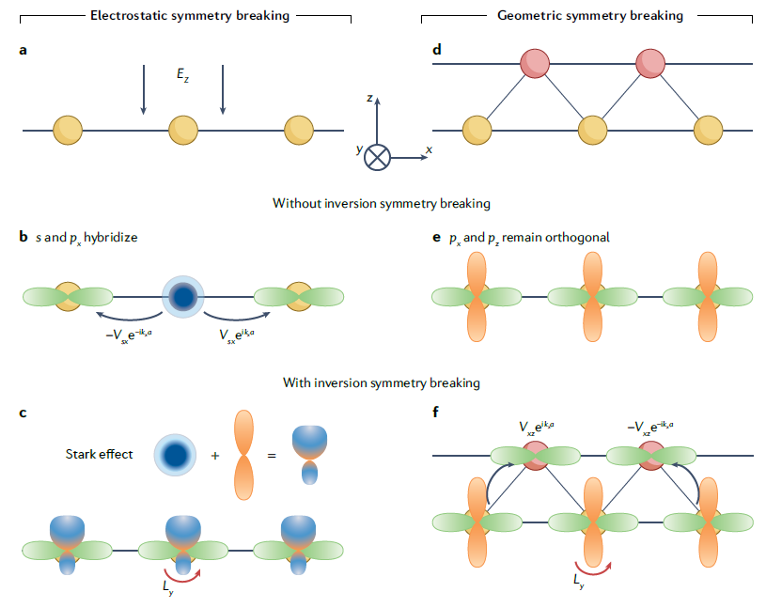The new world of Rashba-like physics: mechanisms, materials, effects
Spintronic devices are based on the inherent spin magnetic moment of the electron, the same way electronic ones are on just its charge, to store and process information. These devices should, in theory, operate faster and at lower temperatures than their current electronic-only counterparts because an electron’s spin can be flipped much quicker than its charge can be moved.
The whole field of spintronics is based on the foundational theoretical work of Emmanuel Rashba who, in 1959, was the first to discover the splitting of the spin-up and spin-down states in energy and momentum with an applied electric field instead of a magnetic field. This is the Rashba effect.
In current terms, the Rashba effect could be described as a momentum-dependent splitting of spin bands in bulk crystals and low-dimensional condensed matter systems (such as heterostructures and surface states). The effect stems from the coexistence of inversion symmetry breaking and spin–orbit coupling. Spin–orbit coupling is a relativistic effect that connects the spin angular momentum of the charge carrier with the electrostatic potential of its environment.
The Rashba effect is ubiquitous in condensed matter and exists in a wide variety of systems and heterostructures, including semiconductors, metals, superconductors and correlated materials. The impact of the Rashba effect extends far beyond spin transport and is at the basis of several key concepts in topological insulators, semimetals and superconductors.
In materials lacking a centre of inversion, this interaction adopts a unique form loosely called Rashba-like spin–orbit coupling that opens a particularly rich playground for scientists and materials engineers by unlocking new functionalities.. In the past few years, the field of ‘Rashba physics’ has progressively widened in three main aspects: mechanisms, materials and effects that can be exploited for potential applications. Now, a team of researchers reviews 1 the most recent advances in this three areas.

Rashba-like spin–orbit coupling.
Conventionally, the term ‘Rashba effect’ refers to a spin splitting that is linear in momentum, but when atomic orbitals of general symmetry (such as p or d) are involved, higher-order effects are observed. Outside this convention, new mechanisms are to be found in newly discovered materials, including 2D ‘Janus’ monolayers, centrosymmetric crystals with inversion partners in their unit cell, materials exhibiting orbital angular momentum texture, and materials that display Rashba-like spin textures even in the absence of spin–orbit coupling.
The development of these new concepts is in part driven by the widening of the basis of materials that have been recently synthesized, such as topological materials, which share the large spin–orbit coupling and the spin–momentum locking scheme with traditional Rashba systems. The researchers also cover the interesting twist that is obtained in magnetic materials, where the magnetization direction is a new degree of freedom to manipulate the spin textures in conventional and topological materials. Strongly correlated materials, including f systems and superconductors, are also reviewed.
Non-equilibrium effects are central to the operation of new spin-based devices. The team examines these phenomena, starting with the interconversion of spin and charge currents by the Rashba effect, based on the materials already discussed. Besides responses to (static) electric fields, optical techniques that could be used to manipulate the magnitude of the Rashba spin–orbit coupling are also considered.
Finally, the scientists speculate about what the future of the field could bring. A research direction that can potentially bring entirely new ideas to condensed matter physics, they suggest, is the realization of a Rashba-like spin–momentum locking scheme in the absence of spin–orbit coupling. Such schemes can be achieved in non- centrosymmetric non-collinear magnets. Along similar lines, the possibility of designing an orbital-momentum locking scheme opens fascinating perspectives for pure orbitronics.
Author: César Tomé López is a science writer and the editor of Mapping Ignorance
Disclaimer: Parts of this article may have been copied verbatim or almost verbatim from the referenced research papers.
References
- Bihlmayer, G., Noël, P., Vyalikh, D.V., Chulkov, E.V. & Manchon, A. (2022) Rashba-like physics in condensed matter. Nat Rev Phys doi: 10.1038/s42254-022-00490-y ↩